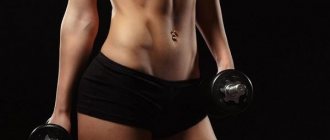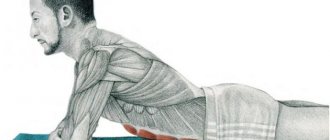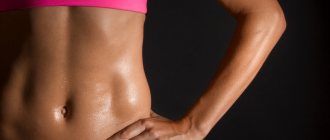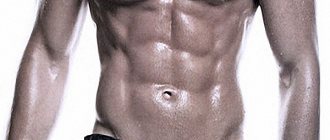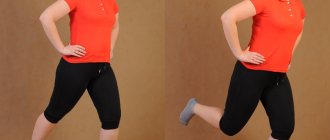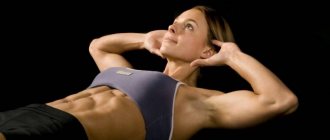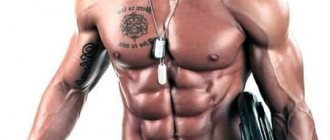What is it and why does it appear?
As a rule, diastasis occurs in pregnant women as a result of increased stress on the abdominal muscles during pregnancy. In rare cases, it may be caused by a genetic predisposition, weak abdominal muscles, or heavy physical activity.
The degree of development of diastasis is determined by the width of the muscle divergence:
- 1st degree – discrepancy 2-5 cm;
- 2nd degree – discrepancy 5-7 cm;
- Grade 3 – discrepancy more than 7 cm.
Based on the location of the discrepancy, it is divided into 3 types:
- above the navel;
- under the navel;
- mixed type (both above and below the navel).
Photo and schematic representation of the divergence of the abdominal muscles after childbirth:
Causes of diastasis and its prevention
Diastasis is the separation of the edges of the abdominal muscles, which occurs due to stretching of the linea alba. The abdomen looks bulging and saggy. We list the main reasons that cause this problem:
- bearing a child and giving birth - due to strong pressure;
- excessive physical activity, heavy lifting for a long time;
- age-related changes - if you do not strengthen the abdominal muscles, the connective tissue begins to weaken;
- violation of metabolism and metabolic processes;
- a large amount of excess weight – obesity.
Prevention of diastasis is based on the causes of its occurrence, not counting pregnancy. To prevent its occurrence, you need to lead a correct lifestyle. Watch your weight, eat healthy food and don’t forget about physical activity (any kind of sport - all sports strengthen the muscle corset). Also, don't allow yourself to overexert yourself by lifting heavy weights.
Interesting: How to remove fat from the stomach and sides at home
How to diagnose diastasis
In order to independently diagnose diastasis, you need to perform the following steps:
- lie down on a hard surface;
- bend your knees;
- place your feet on the floor and move them as close to your buttocks as possible;
- place your fingertips above and below the navel (about 3-5 cm) on the midline of the torso;
- Keeping your abdominal muscles relaxed, lift your head and shoulders off the floor.
If you were able to feel a depression under or above your navel, then you have diastasis. The deeper this depression, the more severe your disease.
Indirectly, divergence of the rectus abdominis muscles is indicated by back pain, an excessively wide waist, a change in the shape of the navel, as well as the presence of a large belly that does not decrease or continues to grow, despite proper nutrition and exercise.
A set of exercises after childbirth
At home, it is easy to perform the following exercises for diastasis of the abdominal muscles. For most of them, they take a fairly comfortable position - lying on their back. The load increases gradually - from 10 repetitions to 25.
In case of second degree discrepancy, the first classes are carried out in a postpartum bandage.
- They lie on their backs, with their head and limbs pressed to the floor. Then the head and shoulders are raised and the position is fixed for 30 seconds. If diastasis is of the second degree, the recommended modification is “hundred”. It differs in the starting position - the legs are bent at the knees, the feet are pressed to the floor. Only the rectus muscles are involved.
- The well-known popular “cat” helps to simultaneously strengthen the rectus, oblique and transverse muscles. Focus on your knees and palms. Next, they arch their back like a cat and pull in their stomach, lowering their head, and then relax again to their original position. You need to pay attention - the exercise begins with arching the back as you exhale, and returns to the starting position as you inhale.
- You should roll over onto your back again - rolling onto your side from the crampon position. Starting position – as in the first exercise. Then the legs are bent and the feet are placed on the floor. The pelvis is torn off for 30 seconds, fixing the position.
- To do the next exercise, you need an additional accessory - a towel. Pose - as in exercise 3, a towel stretched under the waist. You need to take the towel with your hands by the ends, stretch your arms forward, slightly bending at the elbows. As you exhale, raise your shoulders and tighten your waist with a towel, and while inhaling, return to the starting position.
- Very simple exercises that simultaneously strengthen the rectus and transverse muscles. The pose is the same - lying on your back, legs bent. The legs are raised one by one, and while they are raised, they clap their palms on the floor - 5-6 times - as if they are splashing water. After the leg is lowered, while exhaling, turn the hands over and perform reverse movements.
After 3-4 weeks of regular exercise, the exercise can be complicated - add lifts of 2 legs at the same time, or hold the ball between your knees.
The following exercise can be performed at the final stage of strengthening the abdominal muscles - when the discrepancy is almost imperceptible. All muscles are worked out - obliques, rectus, transverse. You need to stand in a knee-elbow position, place your palms (you should pay attention to this) opposite your shoulders. The stomach is pulled in, the right leg and left arm are raised and extended parallel to the floor. The limbs are lowered and the stomach is relaxed. The movements alternate.
What not to do with diastasis
Once diastasis recti is detected, activities that increase intra-abdominal pressure should be avoided. Such activities include lifting heavy objects, loudly laughing or coughing, sleeping on your stomach, slouching, and performing classic abdominal exercises. Workouts that lead to belly growth:
- lifting the body from a lying position;
- push-ups, planks and any exercises that focus on the hands or elbows;
- lifting legs straight or bent at the knees from a lying or hanging position, including “bicycle” and “scissors”;
- power crunches;
- yoga practices that place strong pressure on the midline of the abdomen;
- weighted squats and lunges;
- strong backbends, side bends, pull-ups;
- strength exercises using various weights;
- jumping.
They need to be excluded from your training.
Precautions for postpartum diastasis
When the abdominal muscles diverge after childbirth, it is necessary to pay attention not only to the exercises performed, but also to everyday physical activity.
- When coughing, laughing, or sneezing too much, support your abs with your hands and apply gentle pressure to avoid putting unnecessary pressure on your abdominal muscles.
- Do not lift heavy things over 5-6 kg.
- Lift things weighing less than 5 kg with your arms bent at the elbows (not straight!). When picking things up from the floor, squat rather than bend.
- When rocking your baby, wear a postpartum bandage or tighten the tummy with an elastic bandage.
- Sleep on your side/back (not your chest!).
- Before getting out of bed or lying on it, roll over onto your side. And get up from the “lying on your side” position.
- Before getting up from the chair, you need to shift your weight to your left or right buttock and pull in your stomach. Stand up primarily using your legs, without straining your abs. You can push off with your hands.
How to remove diastasis of the abdominal muscles: recommendations
Figure correction begins 2-2.5 months after birth - when hormonal levels are completely normalized. All this time you need to follow special rules so that the condition does not worsen.
Knowing about your problem, you should avoid actions that provoke an increase in intra-abdominal pressure. Since when caring for a baby it is impossible not to hold him in your arms, you should know how to do it correctly.
You cannot lift a baby—and other heavy objects—with a jerk, like a weightlifter lifting a barbell, with straight arms. The arms must be bent, if the “load” slides along the body, the muscles tense slightly (available weight is up to 6 kg, you cannot lift more).
In the case when the baby has to be rocked in your arms, it is necessary to wear a postpartum bandage.
When coughing or sneezing, the press should be pressed with the palm of your hand; the stomach should not be allowed to inflate.
You need to get out of bed very carefully, first rolling onto your side. Carefully get up from the chair - straining your legs. To make it easier to get up, press your stomach with your palm, transfer your weight to one leg, and lean on the other.
The hardest thing is learning to sleep properly. Many women are accustomed to sleeping on their stomachs and after giving birth quickly return to their previous habits. If you have diastasis problems, it is recommended to sleep on your side or back. To avoid accidentally rolling over, you can lie on your side in advance and place a folded blanket or pillow under you. This will help keep the linea alba from stretching further.
Exercises must be done regularly. If there is not enough time for daily exercise, then you can set aside 2 days for recovery. On these “free” days, an auxiliary complex is performed to strengthen the abdominal muscles. During the day, the stomach is pulled in and held for 25-30 seconds. At least 25 repetitions are required.
Physical exercise
Now let's look at what needs to be done if the abdominal muscles become loose after childbirth. Keep in mind that when performing exercises for diastasis after childbirth, special attention should be paid to breathing. Do not inflate your stomach too much with each breath. And if you are diagnosed with diastasis of 2 or 3 degrees, then you should do the exercises in a bandage.
Exercises for diastasis of the rectus abdominis muscles.
Exercise "Cat"
- Get on all fours (keep your back straight).
- Place your hands shoulder-width apart.
- As you exhale, pull in your stomach and arch your back like a cat.
- Then, as you inhale, bend your back slightly, keeping your tummy pulled in.
- Perform 10-15 repetitions.
“Cat” is the most effective practice not only for eliminating diastasis, but also for preventing spinal diseases and improving overall well-being.
Retraction
- Pull your stomach in as if you were trying to reach your spine with your navel.
- Relax him.
- Quickly alternate between contractions and relaxations. You should get pulsating, rapid movements.
- Perform 5 sets per day with 100 pulses in each set. At the same time, try not to hold your breath during training and breathe as smoothly as possible.
This breathing exercise is convenient because it can be done in any position (while lying, sitting or standing) and at any time (at work or at home while watching a movie).
More useful breathing practices are presented in the video:
Kegel exercise
- Tighten your perineal muscles for about 10 seconds.
- Slowly relax them.
- Do 5 repetitions, each time increasing their number to 25.
This exercise helps strengthen the pelvic floor muscles and prevents prolapse of the internal organs. It is most effective when performed in combination with the breathing practice described above.
Compressions, Julia Tupler's technique
- Lie down on the floor.
- Bend your knees and place your feet on the floor.
- Place a towel under your lower back, cross its ends at your waist and take them in your hands.
- Raise your head and shoulders slightly as you exhale, while squeezing your waist tightly with the towel.
- Hold for a few seconds.
- Return to the starting position.
- Do 10 repetitions.
The method of training the abdominal muscles, invented by American midwife Julia Tupler, is aimed at tightening the abdominal wall. The result is noticeable within a few weeks with regular exercise.
Shoulder Bridge Exercise
- Lie down on the floor.
- Bend your knees (feet parallel to each other, slightly wider than your hips).
- Place your hands along your body, palms down.
- As you exhale, lift your pelvis off the floor and lift it as high as possible, while pulling in your stomach, straining your abs and gluteal muscles. The back should be straight.
- Return to the starting position while inhaling.
- Repeat 10 times.
With this exercise you can also strengthen your lower back muscles and pump up your gluteal muscles.
Exercise "Hundred"
- Starting position: lie on your back, bend your knees, place your feet on the floor, arms along your body, palms down.
- As you exhale, raise your head and shoulders slightly from the floor. You can press your chin to your chest, not forgetting to draw in your stomach. We wait a few seconds.
- As you exhale, we return to the starting position.
- We do 10-15 approaches.
The significant difference between this exercise and the classic abdominal pump is that we raise only the head and a little shoulders, and not the entire body, and draw in the stomach as much as possible. This reduces the load on the abdominal muscles.
Leg Curl
- The starting position is unchanged.
- Alternately bend and straighten your legs. The foot should slide on the floor.
- The number of repetitions for each leg is 10-15 times.
Lumbar stretch
- We leave the starting position the same.
- Pull your stomach in and tilt your head to one side and your knees to the other.
- Stay in this position for a few seconds.
- Next, we perform the same actions, but in a mirror image, keeping the stomach retracted.
- For each side we do 10-15 repetitions.
Leg straightening
- We lie down on the floor.
- Bend your knees and lift them so that your knees are directly above your pelvis. Your arms can be spread shoulder-width apart or extended along your body.
- Slowly lower one leg to the floor and straighten it, sliding your foot along the floor.
- Return to the starting position.
- Do the same actions with the other leg.
- Each leg – 15 repetitions.
What is diastasis recti
Diastasis is the separation of the rectus abdominis muscles. Characterized by the presence of a “dip” in the middle of the press line. Usually the disease is determined during an external examination by a specialist or at home. Most often, diastasis is found in women who have recently given birth. When palpating the press, atrophy, looseness and the presence of a depression are felt. If after birth the separation distance does not exceed 2-3 cm, then it goes away on its own.
Causes
Diastasis (stretching of the aponeurosis) appears in people with connective tissue weakness, in athletes of power sports and in women who have recently given birth. Most often, the disorder is detected in pregnant women in the later stages. The most susceptible to diastasis of the rectus abdominis muscles are girls of an asthenic body type who did not maintain their body in good shape before pregnancy. Less commonly, muscle pathology occurs in athletic women of normal or large build. The more children a mother has, the higher the risk of discrepancy.
Definition of diastasis
If a man is overly involved in physical activity on the abs, diastasis may occur due to increased tension. You need to properly dose the loads and exercise under the guidance of an experienced instructor to avoid sprains.
The third category of people susceptible to diastasis are children with weak connective tissue. If during classes in the sports section the coach gives excessive loads, then the risk of discrepancy increases significantly. Sometimes there are dysplastic children who have congenital weakness of connective tissue. With increased loads in such children, intra-abdominal pressure increases greatly, which provokes the occurrence of abnormal separation of the rectus abdominis muscles.
External signs of a tendency to diastasis in children:
- The presence of valgus limbs or X-shaped legs.
- History of flat feet, valgus gait (the foot rolls inward while walking).
- Frequent subluxations of the ankles.
- During the examination, MARS syndrome is detected - minor anomalies of the heart muscle.
What contributes to stretching of the aponeurosis in pregnant women:
- Increased intra-abdominal pressure that occurs against the background of a growing uterus and fetus.
- Hormonal changes that promote softening of connective and muscle tissue. The hormones progesterone and relaxin are responsible for these metamorphoses. As a result, the muscular-ligamentous apparatus becomes pliable for the passage of the fetus through the pelvic bones. Also, a similar phenomenon affects the abdominal muscles, making them susceptible to stretching.
- Strong weight gain. If a pregnant woman does not monitor her diet and leads a passive lifestyle, this directly affects the size of her belly. The larger it is, the stronger the diastasis.
- Repeated pregnancy. If the intervals between births are too short, less than 2-3 years, then the muscles do not have time to tone up after the previous pregnancy. As a result, pronounced atrophy occurs, and diastasis manifests itself more and more each time. The best prevention of the problem is regular exercise in the gym.
- C-section. During the operation, a surgical dissection of the abdominal wall occurs, which is fraught with consequences. In particular, the risk of stretching the aponeurosis increases with repeated surgery.
Factors that increase the risk of diastasis in both sexes:
- Obesity.
- Extreme weight loss, when body weight decreases by more than 5-10 kg per month.
- Boring cough in the presence of chronic diseases of the respiratory system.
- Increased physical activity, lifting heavy weights.
- Frequent constipation.
- Connective tissue dysplasia.
“To get rid of muscle discrepancy in the postpartum period, you need to choose the right set of exercises with a dosed load. The success of eliminating the defect also depends on the degree of discrepancy.
With the first degree of diastasis, the separation does not exceed the thickness of two fingers, so it goes away on its own.
The second degree (the thickness of the aponeurosis is about 3-4 fingers) requires increased attention. It is necessary to carefully select a set of loads. At the third degree, the discrepancy is too strong. In this situation, surgical intervention is required. Diastasis must be dealt with, otherwise it can cause a hernia.
Symptoms
You can suspect a stretched aponeurosis by external signs - a hanging belly and severe stretching of the abdominal wall after eating. With severe separation, unpleasant symptoms often occur:
- Pain and discomfort in the abdomen, which intensifies with heavy lifting or sports activities.
- Intestinal discomfort, manifested by constipation, flatulence and bloating.
- Prolapse or displacement of internal organs caused by weakness of the abdominal wall.
- Unpleasant sensations in the stomach when walking.
- Weakness and atrophy of the abdominal muscles.
Method for recognizing diastasis at home:
- You need to lie on your back with your legs bent at the knee joint and your feet resting on the floor.
- One hand should be placed under the head.
- The fingers of the other hand should be drawn along the midline of the abdomen in the navel area, lightly pressing the abdominal wall.
- At the same time, you should raise your torso and upper body, as in an abdominal exercise.
- Determine by touch whether there is a stretch. Usually, diastasis of the rectus abdominis muscles is felt immediately, because a small dip appears under the fingers.
Diastasis test
These recommendations are relevant only for those who have a slight divergence of the aponeurosis. With grade 2 or 3 diastasis, stretching of the abdominal wall is visible to the naked eye.
